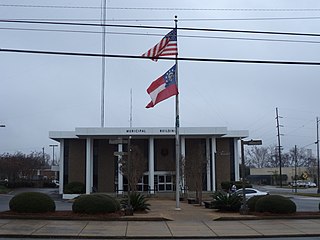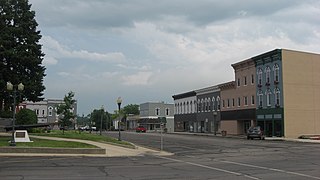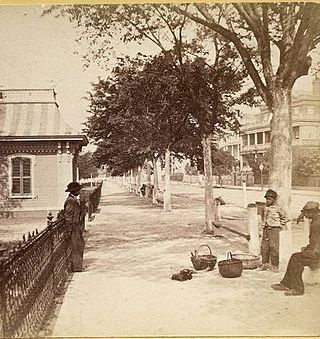
Fort Sumter is a sea fort built on an artificial island near Charleston, South Carolina to defend the region from a naval invasion. It was built after British forces captured and occupied Washington during the War of 1812 via a naval attack. The fort was still incomplete in 1861 when the Battle of Fort Sumter occurred, sparking the American Civil War. It was severely damaged during the battle and left in ruins. Although there were some efforts at reconstruction after the war, the fort as conceived was never completed. Since the middle of the 20th century, Fort Sumter has been open to the public as part of the Fort Sumter and Fort Moultrie National Historical Park, operated by the National Park Service.

Moultrie County is a county in the U.S. state of Illinois. According to the 2020 United States Census, its population was 14,526. Its county seat is Sullivan. The name is pronounced as in "mole tree", unlike the pronunciation of its namesake, the South Carolinian Revolutionary War hero William Moultrie.

Moultrie is the county seat and largest city of Colquitt County, Georgia, United States. It is the third largest city in Southwest Georgia, behind Thomasville and Albany. As of the 2020 census, Moultrie's population was 14,638. It was originally known as Ochlockoney until it was incorporated by the Georgia General Assembly in 1859. Moultrie is an agricultural community set in the Southern Rivers part of Georgia.

Sullivan is a city in Moultrie County, Illinois, United States. The population was 4,413 at the time of the 2020 census. It is the county seat and largest city of Moultrie County. Sullivan is named after Sullivan's Island, South Carolina, where Fort Moultrie is located.

Sullivan's Island, historically known as O'Sullivan's Island, is a town and island in Charleston County, South Carolina, United States, at the entrance to Charleston Harbor, with a population of 1,791 at the 2010 census, and 1,891 people in 2020. The town is part of the Charleston metropolitan area, and is considered a very affluent suburb of Charleston.

William Moultrie was an American planter and politician who became a general in the American Revolutionary War. As colonel leading a state militia, in 1776 he prevented the British from taking Charleston, and Fort Moultrie was named in his honor.

Morris Island is an 840-acre (3.4 km²) uninhabited island in Charleston Harbor in South Carolina, accessible only by boat. The island lies in the outer reaches of the harbor and was thus a strategic location in the American Civil War. The island is part of the cities of Charleston and Folly Beach, in Charleston County.

The Battle of Fort Sumter was the bombardment of Fort Sumter near Charleston, South Carolina by the South Carolina militia. It ended with its surrender by the United States Army, beginning the American Civil War.

The flag of South Carolina is a symbol of the U.S. state of South Carolina consisting of a blue field with a white palmetto tree and white crescent. Roots of this design have existed in some form since 1775, being based on one of the first American Revolutionary War flags. While keeping most of its design intact since its adoption, it has varied over the years.

Fort Moultrie is a series of fortifications on Sullivan's Island, South Carolina, built to protect the city of Charleston, South Carolina. The first fort, formerly named Fort Sullivan, built of palmetto logs, inspired the flag and nickname of South Carolina, as "The Palmetto State". The fort was renamed for the U.S. patriot commander in the Battle of Sullivan's Island, General William Moultrie. During British occupation, in 1780–1782, the fort was known as Fort Arbuthnot.

William Jasper was a noted American soldier in the Revolutionary War. He was a sergeant in the 2nd South Carolina Regiment.

Fort Sumter and Fort Moultrie National Historical Park is a United States National Historical Park located in Charleston County, in coastal South Carolina. It mainly protects Fort Sumter, Fort Moultrie, the Charleston Light and Liberty Square. It was known as Fort Sumter National Monument until it was renamed in the John D. Dingell Jr. Conservation, Management, and Recreation Act, signed March 12, 2019.

The Battery is a landmark defensive seawall and promenade in Charleston, South Carolina. Named for a civil-war coastal defense artillery battery at the site, it stretches along the lower shores of the Charleston peninsula, bordered by the Ashley and Cooper Rivers, which meet here to form Charleston harbor.

White Point Garden is a 5.7 acre public park located in peninsular Charleston, South Carolina, at the tip of the peninsula. It is the southern terminus for the Battery, a defensive seawall and promenade. It is bounded by East Battery, Murray Blvd., King St., and South Battery.

Fort Monroe is a former military installation in Hampton, Virginia, at Old Point Comfort, the southern tip of the Virginia Peninsula, United States. It is currently managed by partnership between the Fort Monroe Authority for the Commonwealth of Virginia, the National Park Service, and the city of Hampton as the Fort Monroe National Monument. Along with Fort Wool, Fort Monroe originally guarded the navigation channel between the Chesapeake Bay and Hampton Roads—the natural roadstead at the confluence of the Elizabeth, the Nansemond and the James rivers.

The Battle of Sullivan's Island or the Battle of Fort Sullivan was fought on June 28, 1776, during the American Revolutionary War. It took place near Charleston, South Carolina, during the first British attempt to capture the city from American forces. It is also sometimes referred to as the first siege of Charleston, owing to a more successful British siege in 1780.

The Moultrie Flag, also known as the Liberty Flag, was a flag flown in the American Revolutionary War.

Battery Gadsden is a historic artillery battery located at Sullivan's Island, Charleston County, South Carolina. It was built in 1903–1904, and is one of a series of batteries stretching from Fort Moultrie to the eastern end of Sullivan's Island. It was named after Christopher Gadsden. Until decommissioned in 1917, the concrete battery housed four, six inch guns. It measures approximately 377 feet long and 84 feet wide, with the front or ocean side of the battery at approximately 7 feet high. Battery Gadsden and its neighbor Battery Thomson provided fortification at the mouth of Charleston Harbor. The battery now houses the Edgar Allan Poe Branch of the Charleston County Public Library. It was built at the same time as Battery Jasper.

Battery Thomson is a historic artillery battery located at Sullivan's Island, Charleston County, South Carolina. It was built in 1906–1909, and is one of a series of batteries stretching from Fort Moultrie to the eastern end of Sullivan's Island. Until decommissioned in 1947, the concrete battery housed two, ten inch guns. It measures approximately 326 feet long and 84 feet wide, with the front or ocean side of the battery at approximately 10 feet high. Battery Thomson and its neighbor Battery Gadsden provided fortification at the mouth of Charleston Harbor. It is built in the same style of Battery Jasper.

The Defenders of Fort Moultrie, also commonly known as the Jasper Monument, is a monument in Charleston, South Carolina, United States. Located in White Point Garden, the monument depicts Sergeant William Jasper and was dedicated in 1877 to all South Carolina militiamen involved in the Battle of Sullivan's Island during the American Revolutionary War.























